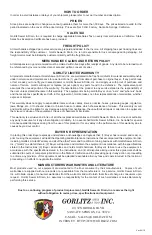
while the machine remains in the forward position. Once the cable and attachment has entered the pipe and
encountered the obstruction, the technician has two choices. He can push the obstruction through the pipe, or
he can try to retrieve the obstruction (or pieces of it) to determine the type of obstruction he is dealing with. The
wise choice is to retrieve the cable and attachment to look for telltale signs. The technician may be lucky and
have caused the obstruction to pass through the pipe. In this case, it doesn’t matter what the obstruction was.
If, however, this is not the case, observation is necessary.
Roots may be immediately noticeable on the attachment or wrapped around the cable. A technician
will cut and retrieve a multitude of times when dealing with roots. If mud is noticed on the attachment, there
may be broken or collapsed pipe. If the attachment is shiny or polished, contact with sand or gravel bedding
is indicated-yet another sign of defective pipe. Digging may be necessary. The most important technique in
cleaning drains and sewers is never to force the cable let the machine and the cable do the work. The only way
a cable can kink or break is if the front of the cable with attachment is locked in an obstruction and the drum (or
machine) continues to rotate. One of three possibilities exist (1) the attachment will cut loose the obstruction and
release the tension on the cable (2) the attachment will lock into the obstruction and the strength of the cable
causes the motor to slow down or (3) the attachment will break away from the cable.
Since there are three options, if the cable continues to rotate, it makes good sense to know when to
rotate or not to rotate the cable. A skilled operator only builds up torque to a point prior to the cable kinking or
breaking. If the torque is not released, then the operator must release the tension on the cable by releasing the
foot-pedal which will allow tension to be released on the cable. After cable has been torqued thousands of times,
it begins losing strength. A worn cable will eventually kink or break if it is continuously used. A smart operator
replaces cable before it wears out.
A skilled technician also knows there is a big difference between a pipe which has been opened and
one which has been cleaned. Earlier I mentioned that discretion dictates using a smaller blade in a pipe and
passing through the pipe completely before returning with a blade the size of the pipe to actually clean the pipe.
Too often, in an effort to maximize revenue a pipe is only opened. The technician fails to make a second pass
with an attachment the size of the pipe to thoroughly clean the pipe. If one is hoping for a call back in a month
or two, he thinks he had made a wise choice to open the pipe. If the technician is more concerned with building
a reputation than a short-term monetary gain, he will thoroughly clean the pipe. I’m reminded of the commercial
of the auto mechanic talking about changing an oil filter on an automobile regularly. He says, “you can pay me
now (for an oil filter) or pay me later (for a new engine.)” The same holds true for the service technician. If you
don’t do the job properly the first time, your competitor will do it properly the next time. The choice is yours.
Anyone can attempt to clean a drain or sewer. All he has to do is rent a sewer cleaning machine.
However, only a professional knows the safe, efficient and effective way to clean a pipe. That’s why it pays the
customer to call a professional drain and sewer cleaner.
Printed with permission by Spartan Tool, a division of Pettibone Corporation. Copyright 1992
You can purchase The Professional Handbook-Drain and Sewer Cleaners at our website:
https://www.gorlitz.com/drain-cleaning-machines/Handbook.asp
25 Gorlitz Operating & Maintenance Manual



































